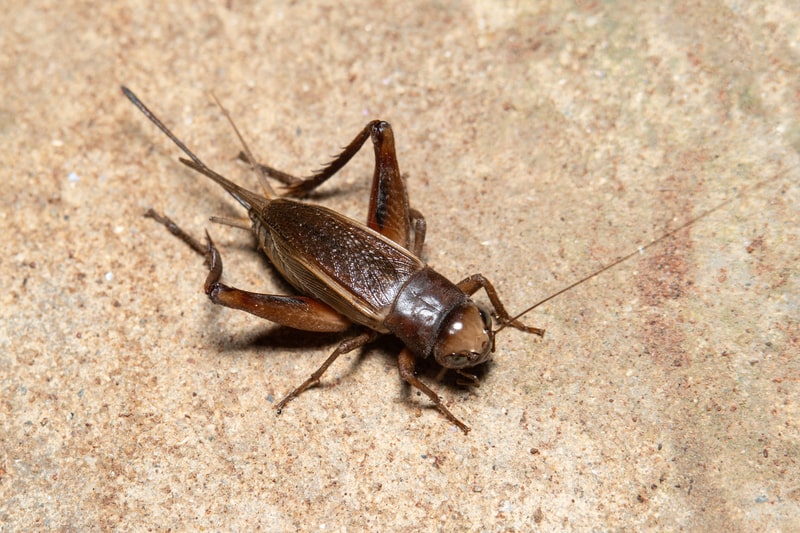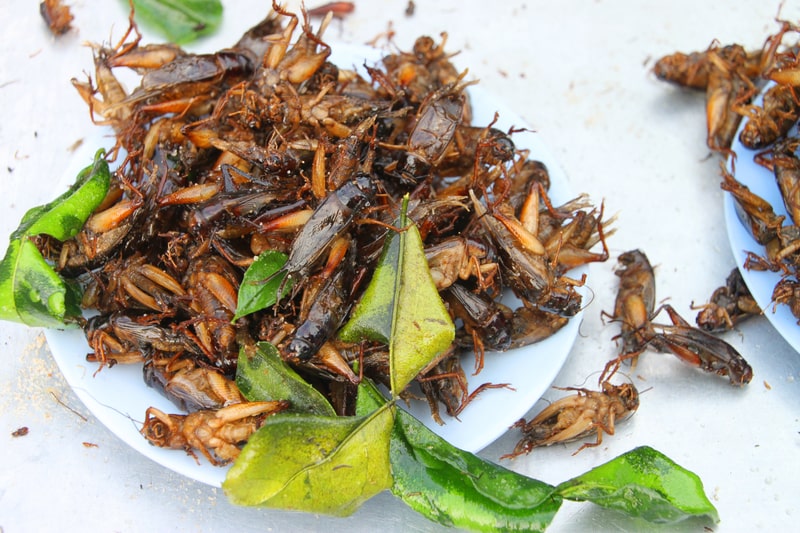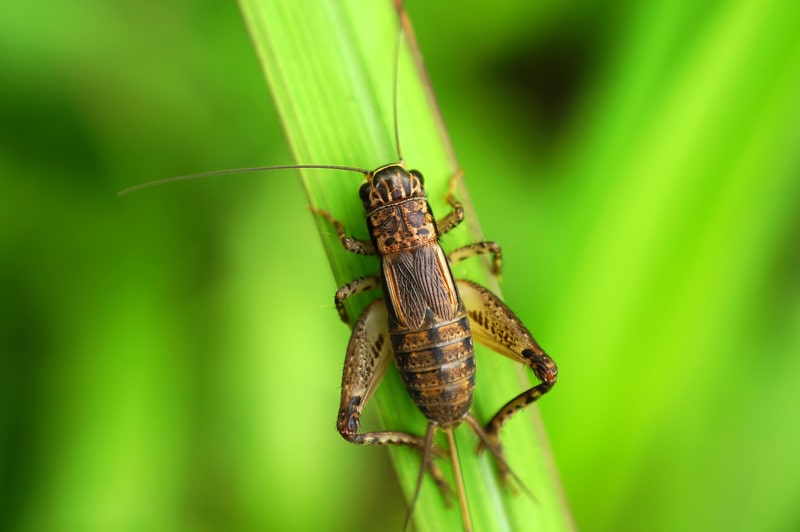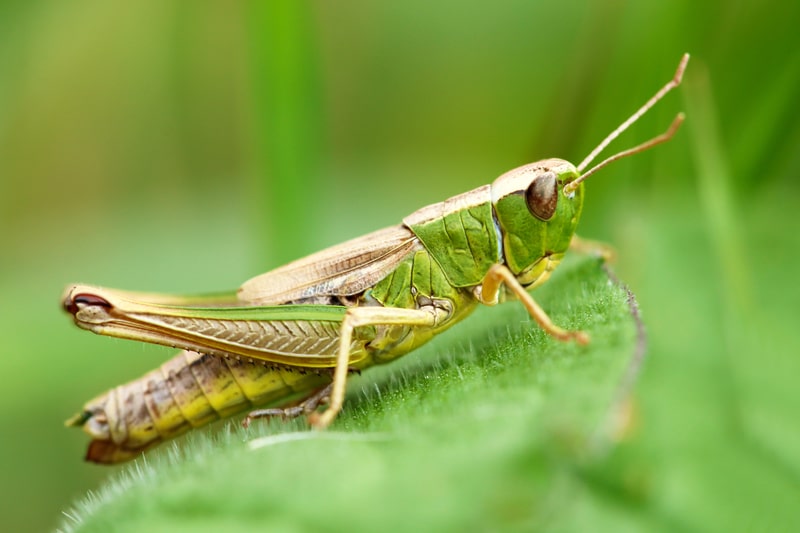Crickets are small and highly vocal pests. These critters often serve as a tasty source of protein for small birds, rodents, reptiles, and amphibians. While harmless when outdoors if you don't mind the sound, crickets can cause damage if they make it inside your home by feeding on some of your belongings.
In this article, we'll share some of the most common questions we hear about crickets, including:
- What are crickets?
- What do crickets look like?
- What are common cricket colors?
- Cricket habitat and behaviors
- What do crickets eat?
- Cricket reproduction and life cycle stages
- How and why do crickets make that chirping sound?
- Where do crickets come from?
- What are common cricket predators?
- Why do people eat crickets?
- Do crickets climb walls?
- Do crickets fly?
- Do crickets bite?
- Are crickets harmful to plants?
- Are crickets harmful to pets?
- Are crickets harmful to people?
- What is the difference between a cricket and a grasshopper?
- What attracts crickets to my house?
- How do I keep crickets away?
- What are the signs of a cricket infestation?
- How do I get rid of crickets in my house?
What are crickets?
Crickets are insects that belong to the order of Orthoptera and are distantly related to grasshoppers. These omnivorous pests are unpleasant neighbors who, in their search for food, can chew on paper and fabric – much to the chagrin of homeowners.
In this article, you'll learn many important facts about crickets and their habits. You'll also get tips on how to get rid of these insects and help keep them away from your home.
What do crickets look like?
While more than 900 species of crickets exist, most of them look alike. They have cylinder-shaped bodies, six legs, and two long antennae. Like grasshoppers, crickets have long hind legs that allow most species to jump as far as 30 inches. Some cricket species have wings and can fly.
Crickets span the gamut of sizing and can range from 1/12 of an inch in length to 2 inches long.

What are common cricket colors?
Crickets vary in color depending on their species. Some of them are pitch black while others are yellowish, tan, or even green in color. You're likely most familiar with the common house cricket, which is tan with three dark bands on top of its head. Mole crickets are light brown while field crickets are dark brown and black.
Cricket habitat and behaviors
Crickets live in various habitats, including caves, forests, meadows, grasslands, beaches, and even underground. They sleep during the day, searching for food and partners at night. These insects are mostly famous for the loud noises that males make to attract females.
Field and house crickets especially gravitate towards bright lights. For this reason, these critters may be attracted to your home and gain entrance through open doors and windows, as well as cracks in the foundation or siding.
What do crickets eat?
Crickets are omnivores and will eat just about anything. When outdoors, they feed on plants, grains, veggies, grasses, mulch clippings, flowers, and seeds. If they settle in your home, crickets are likely to munch on fabric, paper, and any food you leave behind. Crickets are partial to either cooked or raw carrots, as well as bananas, seeds, nuts, and poultry. Your garbage can be a veritable buffet for these omnivorous insects.
Cricket reproduction and life cycle stages
Crickets have a three-stage lifecycle. They start as an egg, which then hatches into the nymph stage. Cricket nymphs (or larvae) look like a smaller, wingless version of a fully-grown cricket and are only ⅛ of an inch long. Depending on the species, a cricket nymph will molt approximately six to 12 times before it is fully developed. This nymph stage can last between two to four months.
Adult crickets have wings and use them to make a chirping sound, which is their mating call. Depending on the species and the environment they live in, most crickets typically live for approximately six weeks once they reach their adult stage. However, under optimal temperatures (between 80 and 90 degrees Fahrenheit), crickets can live longer. Some pet crickets have been known to live in captivity for nearly a year.
Female crickets can start laying eggs within a week of becoming an adult. One cricket can lay up to 100 eggs throughout the course of its lifetime – and sometimes up to 200 eggs.
What are the types of crickets?
While there are over 900 cricket species in the world, the most common are:
- House crickets (Acheta domesticus)
- Field crickets (Gryllina)
- Mole crickets (Gryllotalpidae)
- Jerusalem crickets (Stenopelmatini)
- Camel crickets, sometimes called “cave crickets" or “spider crickets" (Rhaphidophoridae)
- Mormon crickets (Anabrus simplex)
- The most common cricket in the United States is fall field cricket (Gryllus pennsylvanicus), which can also be found in parts of Canada and Mexico, inhabiting forested regions.
How and why do crickets make that chirping sound?
Male crickets make a loud chirping sound to attract females. Contrary to popular belief, crickets do not make their signature mating call by rubbing their legs together. Rather, they create a chirping sound by rubbing their wings together.
Why do crickets chirp? Sometimes, crickets chirp to announce their victory over another male cricket. The mating and celebration chirping sounds are different.
Some species of crickets (such as the Jerusalem cricket and the camel cricket) do not have wings. As a result, these wingless crickets cannot make a chirping sound.
Where do crickets come from?
Crickets can be found in all parts of the world, but thrive most in warmer temperatures (80 to 90 degrees Fahrenheit). They prefer to settle outdoors. However, sometimes, they enter homes to avoid extreme weather conditions or run away from predators. Crickets are also attracted to light, which may make your porch light or living room lamp particularly alluring.
What are common cricket predators?
Common cricket predators in the wild are snakes, frogs, toads, rats, bats, mice, and small birds. Crickets at the larval or nymph stage are also prey for larger crickets who will eat younger and smaller members of their own species.
Why do people eat crickets?
Crickets are an excellent source of protein. Studies show that they may have more protein than chicken or pork per pound of body weight. In Asian, African, and Latin American countries, eating crickets is a part of the local culture.
Another reason why people are considering crickets as a food source extends well beyond their nutritional value. These protein-rich critters can be ground into a fine powder or flour and may be a more sustainable alternative to other animals, which can consume considerable amounts of resources. Crickets may be a sustainable, eco-friendly alternative to more traditional meats.

Do crickets climb walls?
Crickets are excellent climbers. They can easily run up a vertical surface, such as a wall or fence.
Do crickets fly?
Some cricket species, like field and house crickets, have wings. When needed, they readily use these wings to reach their destination. In many cases, crickets use their wings to fly toward sources of light at nighttime.
Do crickets bite?
Crickets can bite. However, they aren't strong enough to puncture human skin. If they somehow manage to do this, the bite can lead to an infection because crickets can carry such pathogens as E. coli and salmonella on their bodies. And while crickets typically will not bite, their waste can carry these pathogens, as well as tiny worms, making them an unwanted presence in your home.
Are crickets harmful to plants?
Crickets feed on greenery, among other things. As a result, these omnivores can damage both outdoor and indoor plants.
Are crickets harmful to pets?
While crickets aren't usually poisonous to pets, their exoskeletons can irritate your pet's stomach lining and cause vomiting. Additionally, cricket feces may contain worms. If your pet eats cricket waste, it may develop into a parasitic infection.
Are crickets harmful to people?
Crickets aren't dangerous to people. They are more of a nuisance. However, frequent contact with these insects may cause allergic reactions in some individuals. Additionally, crickets and cricket waste may contain pathogens, as well as worms.
While crickets pose a minor threat to humans and their animal companions, they can feed on or damage some of your personal possessions. Crickets are indiscriminate when it comes to food sources and may often feed on fabric – particularly preferring fabrics soiled with perspiration or food.
Certain species of crickets, such as the mole cricket, can also cause damage to your yard by creating burrows in the topsoil. Telltale signs that mole crickets have wreaked havoc on your yard are patches of dying grass and tunnels that damage your lawn's root system. Additionally, predators that may have a hankering for devouring mole crickets (such as raccoons and armadillos) may dig up your yard in search of these pests, leading to even more damage.
What is the difference between a cricket and a grasshopper?
Since crickets and grasshoppers are related, it can be hard to tell them apart. The key difference between these two insects is the length of the antennae. Crickets have long antennae, which can sometimes be as long as their bodies. On the flip side, grasshoppers have shorter antennae.

There is also a difference in the way these two insects make sounds. A cricket will rub both of its wings together to make a chirping sound. Conversely, a grasshopper will rub one of its rear legs against its wing to make noise.

What attracts crickets to my house?
Crickets may come to your house when running from extreme weather conditions and predators. Light sources can attract crickets and entice them into your home through open doors, windows, and cracks in walls, foundation, or siding.
Crickets will entrench themselves in a home where there is plenty of food and water. They also seek out dark, moist places to hide.
How do I keep crickets away?
To prevent crickets from entering your home, you need to seal all cracks and holes in your property's structure. Make your home unappealing to the crickets by reducing the number of moist and dark places and removing clutter.
Additionally, you will want to make it difficult for them to seek out food sources. Be sure your garbage – especially garbage containing leftovers – is neatly tied up and disposed of properly. Be sure to launder clothing and fabrics, as crickets can be attracted to fibers sullied with food or perspiration.
What are the signs of a cricket infestation?
Since crickets are often larger than most household pests and insects, it's easy to notice when they take up residence in your home. If you find chewed-up fabrics and hear loud chirping sounds at night, it's safe to say you have crickets.
How do I get rid of crickets in my house?
When your home is infested with crickets, you need to eliminate warm and moist spots and arrange adequate ventilation in the attic, basement, and crawl spaces to reduce humidity. You can also use a vacuum cleaner to remove crickets and their eggs.
Unfortunately, DIY methods rarely work to tame a cricket problem. You are likely to need professional assistance to help get rid of these annoying pests.
Benefits of choosing Terminix® for your cricket control
The key to battling a cricket infestation is a professional approach. Terminix pest experts use effective techniques to remove these pests from your home. Our expert technicians will recommend a custom approach based on the size and nature of your infestation and help you to enjoy a pest-free environment.
Contact us to schedule a free inspection today!


